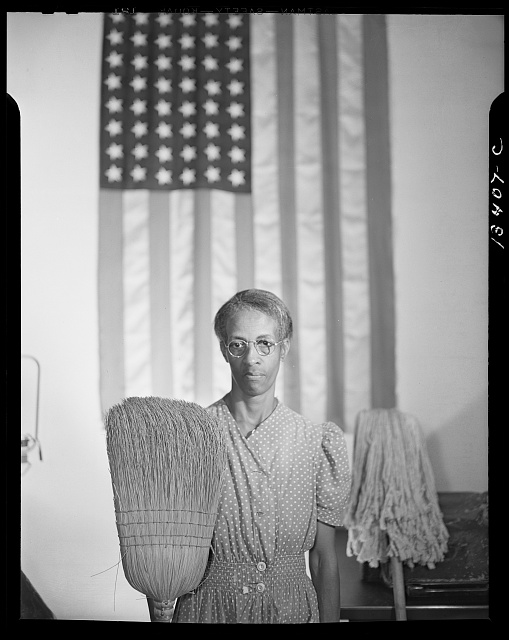Parks... Daaaaaamn Right
Parks was born in 1912 in Kansas in a racially tense area. (Remember, this was only a couple of generations removed from Bloody Kansas.) He grew up there and in Minnesota, and after a series of odd jobs, eventually got into photography, first as a freelance fashion photographer, then for the Farm Security Administration (whose photographic unit was transferred to the Office of War Information in 1943), then Vogue, Glamour, Standard Oil, and finally Life Magazine, where he stayed for 20 years. (That is, if you can call frequent world travel "staying.") For you shutterbugs out there, check out the annual Gordon Parks International Photography Competition sponsored by the community college in his hometown of Fort Scott, Kansas.

American Gothic
Here's part of the story on the FSA photograph of Ella Watson (above), excerpted from the transcript of an excellent oral history interview done for the Smithsonian. Here Parks describes how, new to Washington, he was sent out to do some research by his boss, Roy Stryker:
Roy of course put me through a very strict and revealing process in getting me acquainted with what was going on there, a very sharp, quick thing, at times I thought rather brutal, but he had to shape me up rather quickly. He used a method of taking my camera away from me the first days I got there and sending me out in Washington to the theatres and department stores and drug stores and so forth and I had some rather miserable experiences. Having just come from Minnesota and Chicago, especially Minnesota, things aren't segregated in any sense and very rarely in Chicago, in places at least where I could afford to go, you see. But suddenly you were down to the level of the drugstores on the corner; I used to take my son for a hotdog or malted milk and suddenly they're saying, "We don't serve Negroes," "niggers" in some sections and "You can't go to a picture show." Or "No use stopping, for we can't sell you a coat." Not refusing but not selling me one; circumventing the whole thing, you see? And Roy more or less expected all this, because he could see that I was green as a pea when I came to Washington and not too involved in all this as I might have been, in humanity. So he said, "Go out and see these things, the people, eat here, go to a theatre, go to the department store and buy yourself a coat. You need a coat." And I came back roaring mad and I wanted my camera and he said, "For what?" and I said I wanted to expose some of this corruption down here, this discrimination. And he says, "How you gonna do it?" "Well, with my camera." So he says, "Well, you sit down and write me a little paper on how you intend to do this," and I said, "Fine." I sat down, wrote several papers, brought them in. He kept after me until he got me down to one simple little project. That was my first lesson in how to approach a subject, that you didn't have to go blaring in with all horns blasting away, but I did a picture there that he often laughed at because of, I suppose, of what I thought was the shock appeal of it. He finally got me to talk to a charwoman out in the hall, a Negro lady, and ask her some questions. As simple as that, you know, and I came to find out a very significant thing. She had moved into the building at the same time she said as the woman who was now a notary public. They came there with the same education, the same mental facilities and equipment and she was now scrubbing this woman's room every evening. So out of her I got a charming story but in the heat of all this I took her into this woman's office and there was the American flag and I stood her up with her mop hanging down with the American flag hanging down Grant Wood style and did this marvelous portrait, which Stryker thought it was just about the end.
He also played piano, composed, wrote books, and, starting in the late 60s, made movies. He made The Learning Tree based on his memories of growing up in Kansas, but started to wonder why blacks were largely relegated to either non-threatening, minor supporting or slapstick roles, or else Poitier-esque roles of great stature and seriousness. Why couldn't there be something for the black everyman? 'Why not?' indeed...

And don't forget...
Mr. Parks is still very much alive and with us. I saw him on C-Span a few years ago and he was as lucid an octagenarian as they have ever hosted. You may have seen Parks sitting with Isaac Hayes in the bar, greeted by Richard Roundtree and Samuel L. Jackson (Jackson/Shaft addressed him as "Mr. P"), in John Singelton's very good 2000 Shaft remake/homage. There is a fantastic (but out-of-print!!!) documentary on his life, Half Past Autumn, that I have to recommend strongly. (Ask your library to get it if you can't find it elsewhere.)
PBS News Hour interview here; NPR stories here. And do yourself a favor and check out these excellent annotated galleries and resources from Photo District News and Kodak.











0 Comments:
Post a Comment
<< Home